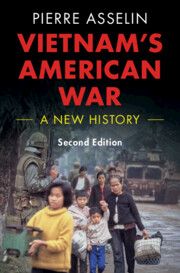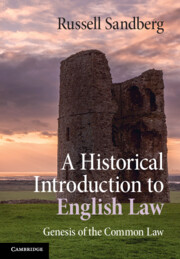2425 results in Cambridge Textbooks

Vietnam's American War
- A New History
- Coming soon
-
- Expected online publication date:
- May 2024
- Print publication:
- 31 May 2024
-
- Textbook
- Export citation
Epilogue
-
- Book:
- A Historical Introduction to English Law
- Published online:
- 04 May 2023
- Print publication:
- 11 May 2023, pp 260-267
-
- Chapter
- Export citation
9 - The Tudor Transformation (c.1485–1603)
-
- Book:
- A Historical Introduction to English Law
- Published online:
- 04 May 2023
- Print publication:
- 11 May 2023, pp 188-231
-
- Chapter
- Export citation
1 - The Need for Legal History
-
- Book:
- A Historical Introduction to English Law
- Published online:
- 04 May 2023
- Print publication:
- 11 May 2023, pp 1-17
-
- Chapter
- Export citation
Afterword
-
- Book:
- A Historical Introduction to English Law
- Published online:
- 04 May 2023
- Print publication:
- 11 May 2023, pp 268-271
-
- Chapter
- Export citation
Prologue
-
- Book:
- A Historical Introduction to English Law
- Published online:
- 04 May 2023
- Print publication:
- 11 May 2023, pp xi-xiv
-
- Chapter
- Export citation
10 - The Stuart Suicide (c.1603–1649)
-
- Book:
- A Historical Introduction to English Law
- Published online:
- 04 May 2023
- Print publication:
- 11 May 2023, pp 232-259
-
- Chapter
- Export citation
2 - The Architects of Legal History
-
- Book:
- A Historical Introduction to English Law
- Published online:
- 04 May 2023
- Print publication:
- 11 May 2023, pp 18-43
-
- Chapter
- Export citation
8 - The Black Death (c.1307–1485)
-
- Book:
- A Historical Introduction to English Law
- Published online:
- 04 May 2023
- Print publication:
- 11 May 2023, pp 156-187
-
- Chapter
- Export citation
6 - The Myth of Magna Carta (c.1215–1272)
-
- Book:
- A Historical Introduction to English Law
- Published online:
- 04 May 2023
- Print publication:
- 11 May 2023, pp 112-135
-
- Chapter
- Export citation
Dedication
-
- Book:
- A Historical Introduction to English Law
- Published online:
- 04 May 2023
- Print publication:
- 11 May 2023, pp v-vi
-
- Chapter
- Export citation
Index
-
- Book:
- A Historical Introduction to English Law
- Published online:
- 04 May 2023
- Print publication:
- 11 May 2023, pp 272-280
-
- Chapter
- Export citation
5 - The Father of the Common Law (c.1154–1215)
-
- Book:
- A Historical Introduction to English Law
- Published online:
- 04 May 2023
- Print publication:
- 11 May 2023, pp 84-111
-
- Chapter
- Export citation
3 - The Anglo-Saxon Legacy
-
- Book:
- A Historical Introduction to English Law
- Published online:
- 04 May 2023
- Print publication:
- 11 May 2023, pp 44-63
-
- Chapter
- Export citation
Copyright page
-
- Book:
- A Historical Introduction to English Law
- Published online:
- 04 May 2023
- Print publication:
- 11 May 2023, pp iv-iv
-
- Chapter
- Export citation
Contents
-
- Book:
- A Historical Introduction to English Law
- Published online:
- 04 May 2023
- Print publication:
- 11 May 2023, pp vii-x
-
- Chapter
- Export citation
4 - The Norman Conquest (c.1066–1154)
-
- Book:
- A Historical Introduction to English Law
- Published online:
- 04 May 2023
- Print publication:
- 11 May 2023, pp 64-83
-
- Chapter
- Export citation
7 - The English Justinian (c.1272–1307)
-
- Book:
- A Historical Introduction to English Law
- Published online:
- 04 May 2023
- Print publication:
- 11 May 2023, pp 136-155
-
- Chapter
- Export citation

A Historical Introduction to English Law
- Genesis of the Common Law
-
- Published online:
- 04 May 2023
- Print publication:
- 11 May 2023
-
- Textbook
- Export citation
Conclusion
-
- Book:
- The People's Dictatorship
- Published online:
- 20 January 2023
- Print publication:
- 26 January 2023, pp 241-244
-
- Chapter
- Export citation



